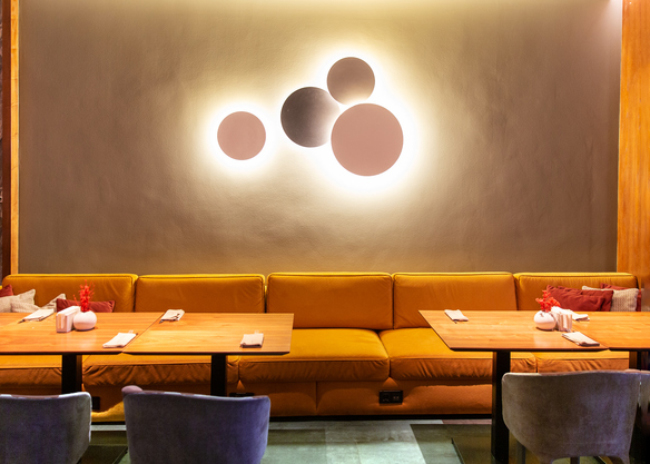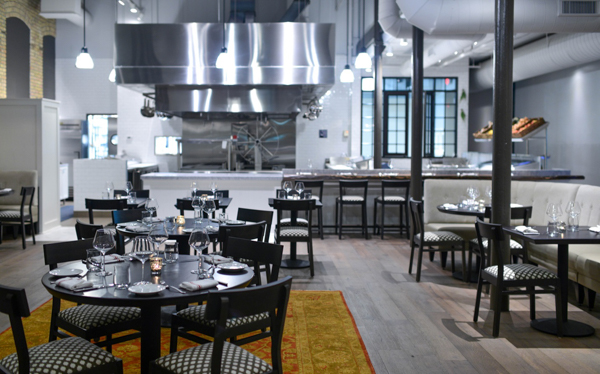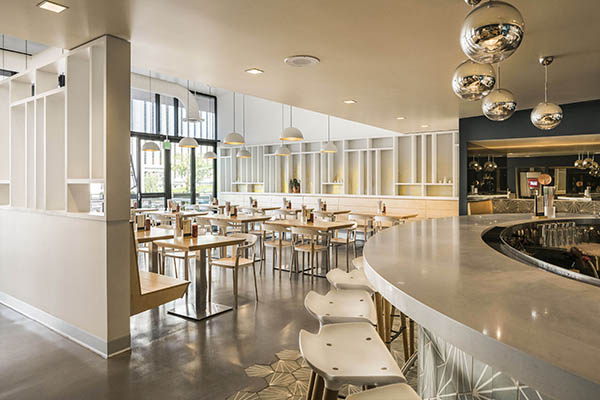 LED, which stands for light-emitting diodes, are said to have been invented by Nick Holonyak, Jr. in 1962, but in the beginning only red and green lighting was available. It wasn’t until the early 2000s that new LED technology ensured commercial spaces could benefit from consistent, flicker-free illumination with true color rendering.
LED, which stands for light-emitting diodes, are said to have been invented by Nick Holonyak, Jr. in 1962, but in the beginning only red and green lighting was available. It wasn’t until the early 2000s that new LED technology ensured commercial spaces could benefit from consistent, flicker-free illumination with true color rendering.
Due to technological advancements, this lighting type has become more widely used in recent years. According to Statista, in 2019, almost half of all light sources in the global market were LEDs, and by 2030 it is projected this number will increase to 87%.
LED 101
It’s becoming increasingly rare to see incandescent lighting, as LEDs can replicate any traditional lighting. It is more versatile, with control over intensity, dimming range, color, temperature and beam spread. These devices are also easier to work with, and there is a wide and growing selection to choose from.
Expanding Options
In the foodservice industry, LED lighting is most prevalent in the front of the house. One reason is that it has become easier to customize these fixtures than in the past for specific functions and purposes. This is not just beneficial for aesthetics, but also for beam spread, color enhancement and dimming capabilities. This lighting type also is available in more sizes and shapes than fluorescent bulbs and generates a lot less heat for more versatile use.
LEDs use significantly less power than fluorescent bulbs. Rather than a thermal creation of light, it’s creating an electro chemical reaction. One of LED lighting’s biggest benefits is that it is more efficient than fluorescent types, which results in energy savings. This type also has a longer life span and offers a higher Color Rendering Index (CRI) than traditional lighting for optimum color appearance.
For added flexibility, this lighting can also provide dimming switches for various power options, such as 40%, 60% and 80%. This also reduces energy output. As this category evolves, more lighting has been developed with micro diodes that enable fixture designs to be more creative and artistic.
When choosing LED lighting, operators need to consider the lumens, or the amount of light generated by the light source. These fixtures can come with multiple settings, with restaurants typically utilizing 3000 to 4000 lumens in the front of house.
LEDs also offer flexibility in both color rendering and power output. It is also necessary to calculate beam spread or how light is dispersed. The closer lighting is to the surface, the more power it has.
In addition, there are several options available, such as electronic controls, motion sensors and dimming controls. Built-in electronics can integrate with Wi-Fi and more sophisticated controls.
Like with fluorescent lighting, there are different types of LED options for the front of house, including recessed cans and strips, in addition to architectural, decorative and workhorse lighting for direct and indirect illumination.
LEDs used in the back of house must be NSF rated and certified for foodservice use. These fixtures also should be waterproof and easy to clean.
What’s Trending
With today’s technology, shapes, sizes and formats for LED lighting are almost limitless. For this reason, several trends are emerging in the foodservice industry. More often this type is used as accent lighting as well as being integrated in furniture and fixtures. Designs have become more complicated and adjustability with brightness and color provides added versatility. Beam direction can be easily adjusted for highlighting products or areas, such as in a buffet or self-serve station.
There has been a significant uptick in acoustical lighting like baffles and wall panel systems in high-end foodservice operations. These include integral lighting and sell as one unit or a total package.
LED fixtures have become more approachable and accessible, with different design elements. Sizes of LED fixtures are shrinking due to microelectronics. Track heads are smaller, as well. There are also more fixtures available that create different glows, including edge and shelving lighting. This allows designers to create custom light features.
In addition to the Wi-Fi controls, smartphone capabilities to control lighting levels have become more widely used. This lighting is more apt to offer options such as selectable power and color controls.
Emergency LED lighting has become more common and typically includes battery backup in case of an outage.
Though LEDs last longer than fluorescent lights, efficiency can deteriorate over time. Most carry a five-year warranty. This lighting is heat sensitive, which can cause premature failure. For this reason, airflow around the LEDs should be sufficient for adequate cooling.
Purchasing Considerations
When incorporating LED lighting, there are several factors to keep in mind.
LEDs can help set a mood, depending on the intensity of lighting or foot candles. It’s important to decide how much light is needed and if any areas need highlighting, like self-service stations or wall art, for example. In fine dining operations, burning candles on tables can be replaced by flickering LEDs. Light color can go from very cool with a daylight effect or warmer to simulate candlelight.
It’s important to be considerate of any glare that will impact customers. Lighting engineers should set up fixtures so that the light doesn’t overwhelm diners seated at the tables.
If LEDs are used in food prep or food display areas, utilizing the correct color rendering ensures each item’s appearance is shown in the best light. High CRI is not as critical in quick-service operations.
Proper controls are needed to get the full benefit of LEDs. This provides subtle and precise changes for dimming.
In addition to CRI, power level, glare, lens type, shielding and intensity should be considered.
One aspect that impacts cost is whether the LED fixture’s chip board can be changed out when needed. If decorative lighting stops working in five years and the chip board can’t be replaced, this could be costly. This is especially true if a fixture has been discontinued, as the expense to replace all matching lighting can be high.
Another aspect of LEDs in restaurants is dimming capabilities. It’s recommended to incorporate lighting that can be dimmed between 1% and 5% of total power, otherwise there is a risk of flickering. This also can happen if the fixture isn’t compatible with the dimming system. A lighting engineer or electrician can verify compatibility.
Fortunately, adding LED lighting in new builds is not an issue, as this is typically designed as a package that includes controls. However, there may be issues when retrofitting these fixtures in existing buildings that have older controls, especially when dimming is factored in. There may be a limited dimming range, or this feature may not work properly. In this case, controls may need to be updated.
It’s becoming increasingly rare to see incandescent lighting, as LEDs can replicate any traditional lighting. It is more versatile, with control over intensity, dimming range, color, temperature and beam spread. These devices are also easier to work with, and there is a wide and growing selection to choose from.
LED, which stands for light-emitting diodes, are said to have been invented by Nick Holonyak, Jr. in 1962, but in the beginning only red and green lighting was available. It wasn’t until the early 2000s that new LED technology ensured commercial spaces could benefit from consistent, flicker-free illumination with true color rendering.
Due to technological advancements, this lighting type has become more widely used in recent years. According to Statista, in 2019, almost half of all light sources in the global market were LEDs, and by 2030 it is projected this number will increase to 87%.



